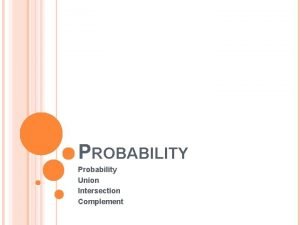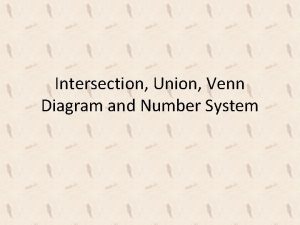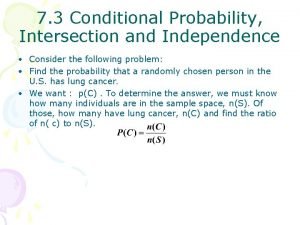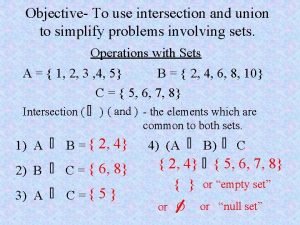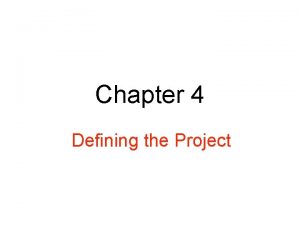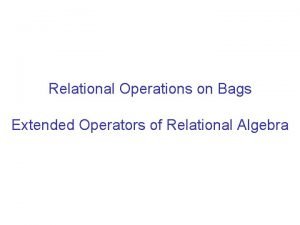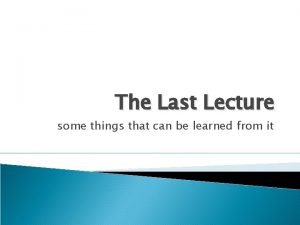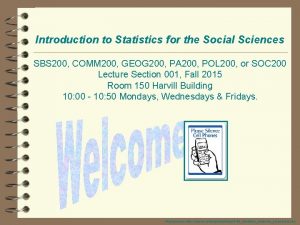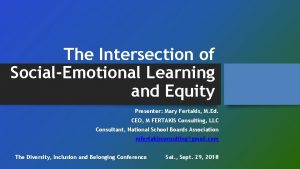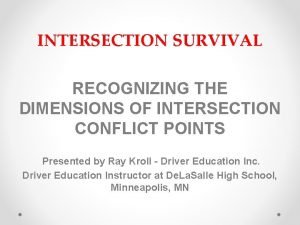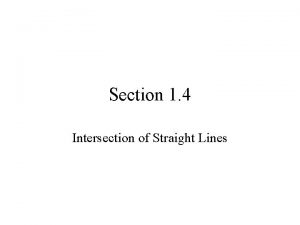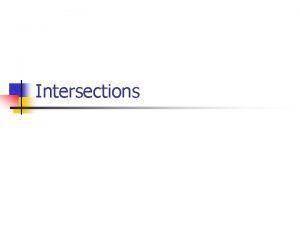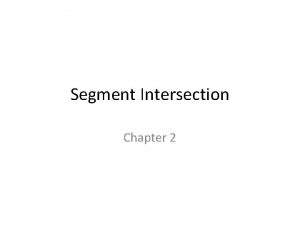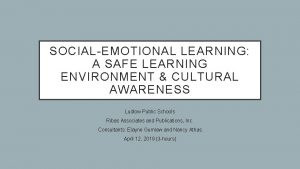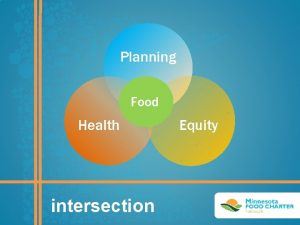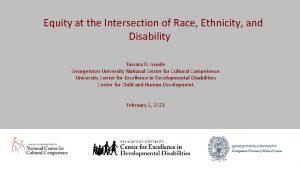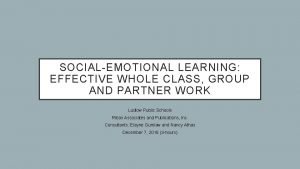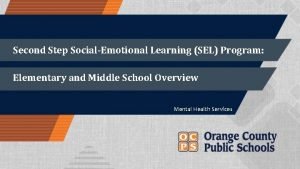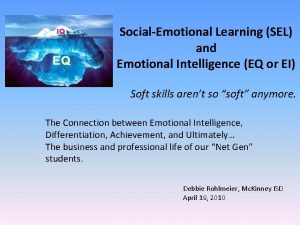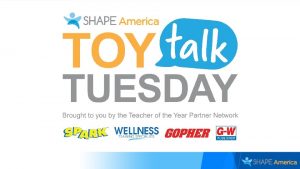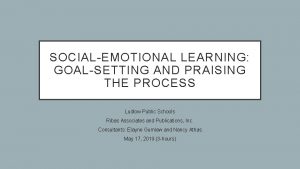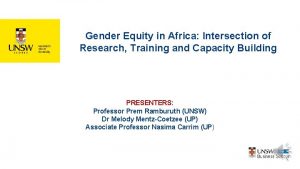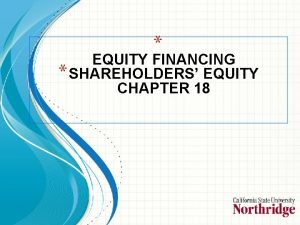The Intersection of SocialEmotional Learning and Equity Presenter
























![Behaviors (Centers for Disease Control and Prevention [CDC], 2014) Complex Trauma/Anxiety • Impulsive • Behaviors (Centers for Disease Control and Prevention [CDC], 2014) Complex Trauma/Anxiety • Impulsive •](https://slidetodoc.com/presentation_image_h/f6a4abd475726358a673c189e9d007df/image-25.jpg)





























- Slides: 54

The Intersection of Social-Emotional Learning and Equity Presenter: Mary Fertakis, M. Ed. CEO, M FERTAKIS Consulting, LLC Consultant, National School Boards Association mfertakisconsulting@gmail. com YDECK Whole Child, Whole Day Symposium Friday, August 10, 2018

Learner Outcomes • Gain an understanding of the differences between Equity, Equality, Educational Equity, and SEL and Equity. • Gain an understanding of SEL Principles, ACE’s (Adverse Childhood Experiences), and Toxic Stress/Trauma issues. • Explore how SEL and Equity intersect. • Learn strategies to ensure SEL is a part of equitable policy, strategic plan, and resource allocation decisions.

Norms for Equity Discussions (adapted from Glenn Singleton’s Courageous Conversations About Race) • Speak Your Truth • Stay Engaged • Expect to Experience Discomfort at Some Level • Be Aware of Intent; Own Your Impact • Accept and Expect Non-Closure • Maintain a Learner Stance and Remain Open to New Thinking

ACTIVITY – Standing in Another’s Shoes Directions: § Do NOT write your name on the sheet in front of you. § Respond to each of the questions by placing an “X” on the line next to any statement that applies to you. § Fold your paper in half when finished. § When directed, stand up, and pass the sheet of paper 5 times (to five different people)

What is Equity? Equality Equity Educational Equity Each person receives the SAME amount of resources, attention and supports. Each person receives the amount they NEED in the way of resources, attention and supports. Every student has access to the resources and educational rigor they NEED at the right moment in their education, regardless of race, gender, ethnicity, language, ability, family background, or family income.

Equality vs. Equity (Graphic by Robert Wood Johnson Foundation)

What is Social-Emotional Learning? The Collaborative for Academic, Social and Emotional Learning (CASEL) The process through which children and adults acquire and effectively apply the knowledge, attitudes, and skills necessary to: Understand Manage Emotions Set and Achieve Positive Goals Feel and Show Empathy for Others Establish and Maintain Positive Relationships Make Responsible Decisions

Researchers generally agree upon five key competencies of SEL (Durlak, Weissberg, Dymnicki, Taylor & Schellinger, 2011)

SEL Core Competencies: Self-Awareness The ability to accurately recognize one’s own emotions, thoughts, and values and how they influence behavior. The ability to accurately assess one’s strengths and limitations, with a well-grounded sense of confidence, optimism, and a “growth mindset. ” • • • Identifying emotions Accurate self-perception Recognizing strengths Self-confidence Self-efficacy -> What are my thoughts & feelings? -> What causes these thoughts & feelings? -> How can I express my thoughts & feelings respectfully?

SEL Core Competencies: Self-Management The ability to successfully regulate one’s emotions, thoughts, and behaviors in different situations — effectively managing stress, controlling impulses, and motivating oneself. The ability to set and work toward personal and academic goals. • • • Impulse control Stress management Self-discipline Self-motivation Goal-setting Organizational skills -> What different responses can I have to an event? -> How can I respond to an event as constructively as possible? -> How can I better understand other people’s thoughts and feelings?

SEL Core Competencies: Social Awareness The ability to take the perspective of and empathize with others, including those from diverse backgrounds and cultures. The ability to understand social and ethical norms for behavior and to recognize family, school, and community resources and supports. • • Perspective-taking Empathy Appreciating diversity Respect for others -> How can I better understand why people think & feel the way they do? -> How can I adjust my actions so that my interactions with different people turn out well?

SEL Core Competencies: Relationship Skills The ability to establish and maintain healthy and rewarding relationships with diverse individuals and groups. The ability to communicate clearly, listen well, cooperate with others, resist inappropriate social pressure, negotiate conflict constructively, and seek and offer help when needed. • • Communication Social engagement Relationship-building Teamwork -> How can I communicate my expectations to other people? -> How can I communicate with other people to understand manage their expectations of me?

SEL Core Competencies: Responsible Decision-Making The ability to make constructive choices about personal behavior and social interactions based on ethical standards, safety concerns, and social norms. The realistic evaluation of consequences of various actions, and a consideration of the well-being of oneself and others. • • • Identifying problems Analyzing situations Solving problems Evaluating Reflecting Ethical responsibility -> What consequences will my actions have on myself and others? -> How do my choices align with my values? -> How can I solve problems creatively?

Benefits of SEL (The Aspen Institute – National Commission on Social, Emotional and Academic Development) • Improved attitudes and behaviors • Reduction in classroom and criminal misconduct, substance abuse, pregnancy, drop out rates, and mental health issues. • Better relationships with peers, families, and adults. • More time spent on teaching and learning; less time spent on classroom management. • Increased academic performance, graduation rates, postsecondary enrollment and completion, employment rates and average wages.

Using SEL Practices to Address Disproportionality • Federal CRDC (Civil Rights Data Center) data on US High School suspensions and expulsions (2013 -14) show: • Black students are 16% of the K-12 population but represent 32 -42% of suspended and expelled students, compared to White students, who are suspended and expelled at similar rates (31 -40%) but represent 50% of the K-12 population. • On average, 4. 6% of White students are suspended, nationally, compared to 16. 4% of Black students - a rate 3 x greater than White students. • In WA (2016 -17), Black students are 4. 4% of K-12 (9. 5% suspended), Latinx students are 22. 8% of K-12 (26% suspended) and White students are 56% of K-12 (49. 8%) were suspended.

Using SEL Practices to Address Disproportionality • Federal CRDC data for pre-school suspensions (2013 -14) show Black children as 19% of all pre-schoolers and accounting for 47% of total suspensions. • Children of color experience trauma at a higher rate than their White peers, and data show children in trauma have higher drop-out and incarceration rates. • In WA, Blacks are 3. 98% of the overall population, yet represent 18. 3% of incarcerated adults (2016) • In WA, Black youth are 4. 4% of the K-12 population, yet represent 20% of incarcerated youth (2016) • In 6 states, African American youth are at least 10 times as likely to be held in placement as are white youth: NJ, WI, MT, DE, CT, and MA (2017)

Adverse Childhood Experiences (ACE’s) Activity: Take the Assessment

Three Types of Adverse Childhood Experiences (ACEs) (Source: Centers for Disease Control & Prevention; Graphic: Robert Wood Johnson Foundation)

ACE’s = Increased Health Risks (Source: Centers for Disease Control & Prevention; Graphic: Robert Wood Johnson Foundation)


Toxic Stress Too much stress = toxic stress (Occurs when a child is overloaded)


The Three Types of Stress Responses: Effects on the Body Positive Stress Response Normal and essential part of healthy development. Tolerable Stress Response Toxic Stress Response Result of more severe, longerlasting difficulties. Result of strong, frequent and/or prolonged adversity. Examples: If time-limited and buffered by relationships, brain and other organs recover. Can disrupt development of brain architecture and other organ systems. 1) First day with a new caregiver Examples: 1) Loss of a loved one 1) Chronic neglect 2) Receiving an immunization shot 2) Experiencing a natural disaster 2) Physical/emotional abuse 3) Frightening injury 4) Family economic hardship 3) Exposure to violence

Causes of Toxic Stress / Complex Trauma (S. Hanauer, D. Lewis, 2014) Student Mobility Emotional Abuse Homelessness Unemployment Poor Nutrition/Hunger Lack of Health Care Chronic Medical Conditions Witness to a Death or Violent Act Physical and/or Emotional Neglect or Abandonment • Birth Defects • • • • • Bullying/Cyber-Bullying/Victimization Anti-Social Peer Groups Learning Disabilities Experience of Racism Poverty History of Suicide in Family Mental Health of Family Member Incarcerated Parent Teen Pregnancy Multiple Changes in Caregivers Loss of Parent due to Death or Divorce
![Behaviors Centers for Disease Control and Prevention CDC 2014 Complex TraumaAnxiety Impulsive Behaviors (Centers for Disease Control and Prevention [CDC], 2014) Complex Trauma/Anxiety • Impulsive •](https://slidetodoc.com/presentation_image_h/f6a4abd475726358a673c189e9d007df/image-25.jpg)
Behaviors (Centers for Disease Control and Prevention [CDC], 2014) Complex Trauma/Anxiety • Impulsive • Difficulty focusing • Anxious and fearful • Memory problems • Poor skill development • Act out in school situations • Act withdrawn • Develop learning disabilities • • • ADHD / ADD Impulsive Trouble staying focused Easily distracted Difficulty with memory Difficulty following instructions Trouble planning ahead and finishing projects

Affluent Student Toxic Stress (Excerpt from Teen Stress: Why Adults Should Be Concerned) “Our youth are stressed to the max, which can lead to so many issues – anxiety, suicidal thoughts, depression, withdrawal. Much of the stress comes from academic pressures and expectations…from society, teachers, parents, media. From a young age, we have our children in extra tutoring, extra coaching, lessons for sports, extra testing to get into better programs, tutoring for testing, music lessons, etc… Don’t buy into the notion that your child needs to be the best of the best at everything …that being stressed out, sleep-deprived and miserable is just a part of being a teenager…that your child won’t be successful without a 4. 0 GPA, 200 hours of volunteer work, 15 AP classes, and five sports championships… Encourage learning, failure and growth rather than expecting perfection. Ask about your child’s well-being before asking about their grades. ”

Trauma-Informed Practices “A trauma-informed approach asks: ‘What happened to you? ’ instead of ‘What’s wrong with you? ’ or ‘Help me better understand your experience. ’” ~David Lewis MA. , LMHC. , Director/Program Manager Behavioral Health Services Seattle Public Schools

What is Trauma? • Definition: A psychologically distressing event that is outside of the range of the usual human experience, often involving a sense of intense fear, terror and helplessness. • 25 -39% of children have experienced or witnessed a traumatic event. • Low-income and children of color are more likely to experience trauma due to their disproportionate exposure to poverty and violence.

Types of Trauma Simple Trauma • • • One-time Victim of a Crime Car Accident House Fire Earthquake Physical Injury Complex Trauma • Ongoing Physical/Emotional Abuse, Bullying, or Victimization • Emotional Neglect • Sexual Abuse • Domestic Violence • Familial Substance Abuse • Placement Disruptions (Foster Care) • Refugee Camp Experience • Chronic Homelessness • Culture Shock - Immigrants

Physiological Impact of Trauma on Children • Children with still-developing neural pathways associated with responses to danger, impulse control, and memory are adversely affected by trauma. • Trauma’s impact on the brain often places children in a state of hyper-arousal, causing them to over-react to situations that are otherwise non-threatening. • Adrenaline levels and heart rates of children living with trauma are higher than their less stressed peers. • Internal response: Lack of motivation; Depression; Declining class participation • External response: Outbursts; Violence; Defiance

Trauma-affected children are significantly different than their peers in these areas: • Concentration • Problem-solving • Abstract thinking • Working collaboratively in groups • Ability to recall facts • Working memory • Comprehension • Classroom and teacher transitions • Forming relationships • Regulating emotions • Organizing material sequentially • Application of knowledge

What are Trauma-Informed Practices? • A framework for understanding, recognizing and responding to the effects trauma can have on a person. • In a school setting, this means there is an understanding that disruptive or hostile behavior is derived from suffering/pain – not from anger. • The behavior does not occur by choice, but is driven by triggers such as a confrontation or change in routine/schedule. • Prioritizes treatment over punishment. • Does NOT mean the absence of discipline. • Focus is on building opportunities for students to succeed by helping them regulate their emotions, and create an environment where they feel safe, and connected to caring adults. • Examples of Practices/Programs: • Guided Meditation; Mindfulness; Collaborative Problem-Solving; Positive Behavioral Intervention and Supports (PBIS); being a “Warm Demander”

When Students Are Traumatized, Teachers Can Be Too • Vicarious Trauma – a secondary type of trauma, sometimes referred to as “the cost of caring”. • Can result from “hearing [people’s] trauma stories and becom[ing] witnesses to the pain, fear and terror that trauma survivors have endured. ” (American Counseling Assn. ). • Is a concern for teachers who work in high-needs settings and are directly exposed to a large number of young people who have/are experiencing trauma. • PD is important for school staff in these settings to learn how to navigate trauma. * Resource: Trauma Smart (http: //traumasmart. org) – partners with schools and early learning programs to help children and the adults in their lives navigate trauma)

The Intersection of Equity and SEL “If we teach social-emotional learning in ways that ignore equity, we will woefully fail our students, particularly our most disenfranchised. ” ~Dena Simmons, Yale Center for Emotional Intelligence

Intersection of Equity and SEL Equity Every student receives the amount they NEED in the way of resources, attention and supports. Educational Equity SEL and Equity Every student has access to the resources and educational rigor they NEED at the right moment in their education, regardless of race, gender, ethnicity, language, ability, family background, or family income. Every student receives what they NEED to develop to their full academic and social potential regardless of race, gender, ethnicity, language, ability, family background, or family income.

SEL, Equity, and Student Identity • How a student sees her/himself in the world impacts their school experience. -> ACTIVITY: Becoming Joey (poem) • Culture, race, gender, class, sexual identity, language, etc. • Situatedness: How one is positioned relative to opportunity and access. • Identity with peers within school – integration or segregation?

SEL, Equity, and Student Mindset • What are a student’s beliefs about their own learning and capacity? • Do they have a sense of belonging in the academic community? • Do they believe that effort leads to increased ability? • Do they believe that success is possible? • Do they believe that the work has value (is it relevant)?

Students’ Sense of Belonging – Research Says… • When students sense their teachers respect them, trust increases and misbehavior decreases, resulting in lower suspension rates. (Stanford researchers Okonofua, Paunesku & Walton, 2016) • Students whose teachers received PD in the importance of empathy in the classroom were half as likely to be suspended by the end of the school year. • Stronger effects were noted for Black and Latino boys who had been suspended the prior year. • Middle school students who perceive inconsistent treatment for their racial or ethnic group have lower levels of trust for teachers and school officials. (UT-Austin, Columbia & Stanford research project results - “Child Development”, 2017) • Lack of trust in school correlated to higher discipline rates and a lower likelihood of later enrollment in a 4 -year university.

Student’s Sense of Belonging – Research Says… • Students from under-represented groups, or who are part of a group that is subject to negative stereotypes may respond differently to failure or criticism from a teacher. (Bondy, Ross, Gallingane & Hambacker - Urban Education, 2007) • Students view such experiences as confirmation that they are less capable than their peers. • Teachers as “Warm Demanders” (“Expect a great deal from their students, convince them of their own brilliance, and help them reach their potential in a disciplined & structured environment. ” – Lisa Delpit, author of Other People’s Children). • Students from cultural backgrounds that emphasize interdependence and community may struggle in schools that view success as an individual endeavor. (Northwestern, UW, Stanford study, 2012) • First generation college students performed better academically after participating in an exercise that emphasized the value of community.

Developing an Equity Lens for SEL Instruction: Suggestions from a Teacher of Color • Flex your self-awareness muscles to understand your power, privilege and unconscious bias if you come from a different background than your students. • Take the Harvard Implicit Bias Test; read Blindspot: The Hidden Biases of Good People • Read Peggy Mc. Intosh’s “Unpacking the Invisible Knapsack” • Make SEL meaningful and relevant for students. • Don’t impose on students of color one set of values and beliefs about behavior, conflict resolution, relationship-building and decision-making (most curricula in the US come from a White, Western, and individualistic perspective). • Sends a message to students that they are inferior for being who they are. • Allow students space to learn how to navigate the differences between home and school. • Teach “code switching” (altering speech or behavior depending on a given context).

Developing an Equity Lens for SEL Instruction: Suggestions from a Teacher of Color • Build relationships with students, their families and their community • Students: Feel more connected to school (a preventative factor against risky behaviors) and increases their likelihood of academic success; survey them to find out about their hobbies, home lives, academic strengths, areas for growth, social circles, favorite foods, etc. • Families: Establish communication norms to avoid misunderstandings; ask how you can partner together; translate materials. • Community: Conduct an asset-mapping inventory of religious, political, economic, social service and health institutions, as well as identifying who the leaders are in different communities to provide community context.

Equity Questions for SEL Programs & Instruction • Is your SEL program/curriculum being taught in a culturally responsive context? • Does it incorporate and value students’ diverse life experiences? • Does it allow for variations in responses or is one set of cultural norms elevated? • Are students being positioned as the problem, rather than the teacher’s implicit bias/stereotype of groups of children? • Has SEL been introduced into your buildings without changing the curricula, behaviors, and policies that have institutionalized current inequities? • Have staff (not just teachers) received SEL principles and trauma-informed Professional Development?

Measuring SEL – What is the Purpose? (from Measuring SEL: A Brief Guide by Education Northwest) • Identification of Student Need • Trauma-Informed Approach (Front end: Intervene early, before problems arise) • Early Warning Systems (Back-end: Intervene once problems have been detected) • Program Improvement • Priority Setting (Front end: Focus efforts based on students’ current status) • Assessing Change (Back end: Were efforts effective and successful? ) • Accountability • Identify schools, districts or programs in need of additional support • SEL measures must be reliable at the setting/program level • When tied to high-stakes decisions, there is a potential for gaming the measures

Measuring SEL- What to Measure and How? (from Measuring SEL: A Brief Guide by Education Northwest) • What To Measure? • • Areas that have the potential to impact long-term outcomes for students Areas that align with local priorities and goals (what we care about) Areas that are within our power to change Areas that are aligned with existing capacities (structures/resources currently in place to support students and/or inform instruction and programming) • What Tool(s) to Use? • Survey students or adults? (students may be the best judge of their internal beliefs and mindset; adults who work with them may be better judges of their outward behavior) • Does the tool provide accurate, timely information for explicit action(s) to be taken? • How rigorous does it need to be? Is the data intended for internal information gathering or high-stakes decision-making? • Is it practical? (cost; training; is additional technology needed? ; how much time is required to participate? )

APPLICATION of CONTENT

Best Practice Example 1) Note on the first draft of a student essay: “I’m giving you these comments because I have very high expectations and I know that you can reach them. ” VS. “I’m giving you these comments so you’ll have feedback on your paper. ” • Students were more likely to revise their essay when receiving the first note than the control group that received the second note. • The effects were stronger for Black students than other sub-groups.

Best Practice Example 2) Introduction to a Math assignment: “Now this is a tough assignment. In the past, a lot of students have had trouble with it. They came in to ask me questions and I told them they had to figure it out on their own. ” VS. “This next assignment is really tough. You might struggle with it, but I know you can handle it on your own. You might have questions but I’d like you to try and work it out for yourselves. If you get stuck though, you can come talk to me. ” • #2 bolsters students’ confidence and growth mindset, rather than setting them up for anxiety. • When students feel their teachers care, they put forth more effort in that class.

Summary “When we develop SEL skills, our ability to form relationships and build social awareness increases, enhancing our ability to connect with individuals of diverse perspectives, cultures, languages, histories, identities and abilities. By implementing SEL on a macro-level, we create more equitable, better-performing schools and communities. This type of cultural change creates environments in which all students learn the skills needed to be prepared for career, college, and life. ” (Addressing Social Emotional Learning in Washington’s K-12 Public Schools, 2016)

RESOURCES: • Whistling Vivaldi (Claude Steele) • Culturally Responsive Teaching and the Brain (Zaretta Hammond) • Despite the Best Intentions: How Racial Inequality Thrives in Good Schools (A. Lewis & J. Diamond) • Blindspot: Hidden Biases of Good People (Mahzarin R. Banaji & Anthony G. Greenwald) • Why We Drop Out: Understanding and Disrupting Pathways to Leaving School (Deborah Feldman, Antony Smith, Barbara Waxman) • Fostering Resilient Learners: Strategies for Creating a Trauma-Sensitive Classroom (Kristin Souers & Pete Hall) • Starting Small: Teaching Tolerance in Pre-School and the Early Grades (The Teaching Tolerance Project, Southern Poverty Law Center - forward by Vivian Gussin Paley NOTE: Extensive book list included at the end)

RESOURCES: • The Collaborative for Academic, Social & Emotional Learning (CASEL): http: //casel. org/why-it-matters/what-is-sel/skills. competencies • Economic Benefits of SEL: https: //www. edutopia. org/resource/econ-value-sel-research • Integrating SEL with College/Career Readiness Standards: https: //www. aspeninstitute. org/publications/this-time-with-feeling/ • American School Board Journal: https: //www. nsba. org/newsroom/american-schoolboard-journal/asbj-june-2017/database-sad-not-bad • Trauma-Informed Training: http: //www. sounddiscipline. org/ • Education Week – “Is SEL Really Going to Work for Students of Color? ” (article): http: //mobile. edweek. org/c. jsp? cid=25919701&bcid=25919701&rssid=25919691&item =http%3 A%2 F%2 Fapi. edweek. org%2 Fv 1%2 Ftm%2 F%3 Fuuid%3 DEC 0 C 1 CB 0 -46 D 8 -11 E 7 BBA 9 -D 5 FAB 3743667

RESOURCES: • Teen Stress: https: //eastsideedu. com/teen-stress-adults-concerned/ • Harvard Center for the Developing Child – Toxic Stress: http: //developingchild. harvard. edu/science/key-concepts/toxic-stress/ • “What steps can we take to get started on the journey to become a traumasensitive safe and supportive school? ”: http: //traumasensitiveschools. org/author/tlpi-team/ • ACE’s Quiz and Article – What it Does and Doesn’t Mean: http: //www. npr. org/sections/health-shots/2015/03/02/387007941/take-the-ace -quiz-and-learn-what-it-does-and-doesnt-mean • Finding What’s Right With Children Who Grow Up in High Stress Environments: https: //unews. utah. edu/high-stress-environments/ • Students’ Sense of Belonging: http: //www. edweek. org/ew/articles/2017/06/21/belonging-at-school-startswith-teachers. html

RESOURCES: • Harvard Implicit Bias Test: https: //implicit. harvard. edu/implicit/takeatest. html • Peggy Mc. Intosh – “Unpacking the Invisible Knapsack”: https: //www. deanza. edu/faculty/lewisjulie/White%20 Priviledge%20 Unpacking% 20 the%20 Invisible%20 Knapsack. pdf • Robert Jensen – “The Fears of White People”: http: //www. mccc. edu/pdf/cmn 214/Class%208/The%20 fears%20 of%20 white%20 people. pdf • Damali Ayo – “I Can Fix It!: http: //www. damaliayo. com/pdfs/I%20 CAN%20 FIX%20 IT_racism. pdf • Addressing Social-Emotional Learning in Washington’s K-12 Public Schools (report): http: //www. k 12. wa. us/Workgroups/SELBMeetings/SELBWorkgroup 2016 Report. pdf

RESOURCES: • Suspension Data by Race: http: //files. eric. ed. gov/fulltext/ED 537954. pdf • When Students Are Traumatized, Teachers Can Be Too: http: //www. edutopia. org/article/whenstudents-are-traumatized-teachers-are-too • The Sentencing Project: http: //www. sentencingproject. org/wpcontent/uploads/2016/01/Uneven-Justice-State-Rates-of-Incarceration-by-Race-and. Ethnicity. pdf • US Department of Education, Civil Rights Data Center: https: //ocrdata. ed. gov/downloads/projections/2013 -14/One-out-of-school-suspension. xlsx • The Warm Demander – An Equity Approach: https: //www. edutopia. org/blog/warm-demanderequity-approach-matt-alexander • The Teacher as Warm Demander: http: //www. sjsu. edu/faculty/marachi/mle/Warm%20 Demander%20 Article. pdf

Thank you for attending this session! Mary Fertakis, M. Ed. M FERTAKIS Consulting, LLC mfertakisconsulting@gmail. com
 Adobe presenter
Adobe presenter Cuadro comparativo e-learning y b-learning
Cuadro comparativo e-learning y b-learning Union intersection complement
Union intersection complement Irrational numbers venn diagram
Irrational numbers venn diagram Interpenetration drawing
Interpenetration drawing Intersection and conditional probability
Intersection and conditional probability Draw and label a figure for each relationship
Draw and label a figure for each relationship How to simplify unions and intersections
How to simplify unions and intersections What is dc load line
What is dc load line Efficient private matching and set intersection
Efficient private matching and set intersection Context free language closure properties
Context free language closure properties Coding the wbs for the information system
Coding the wbs for the information system Wbs and obs intersection
Wbs and obs intersection Is the intersection of a plane and a double-napped cone.
Is the intersection of a plane and a double-napped cone. Union and intersection
Union and intersection Luck is the intersection of preparation and opportunity
Luck is the intersection of preparation and opportunity A intersection b
A intersection b Intersection and union of events
Intersection and union of events Hát kết hợp bộ gõ cơ thể
Hát kết hợp bộ gõ cơ thể Ng-html
Ng-html Bổ thể
Bổ thể Tỉ lệ cơ thể trẻ em
Tỉ lệ cơ thể trẻ em Voi kéo gỗ như thế nào
Voi kéo gỗ như thế nào Tư thế worm breton
Tư thế worm breton Hát lên người ơi alleluia
Hát lên người ơi alleluia Các môn thể thao bắt đầu bằng tiếng bóng
Các môn thể thao bắt đầu bằng tiếng bóng Thế nào là hệ số cao nhất
Thế nào là hệ số cao nhất Các châu lục và đại dương trên thế giới
Các châu lục và đại dương trên thế giới Công thức tính độ biến thiên đông lượng
Công thức tính độ biến thiên đông lượng Trời xanh đây là của chúng ta thể thơ
Trời xanh đây là của chúng ta thể thơ Mật thư tọa độ 5x5
Mật thư tọa độ 5x5 101012 bằng
101012 bằng độ dài liên kết
độ dài liên kết Các châu lục và đại dương trên thế giới
Các châu lục và đại dương trên thế giới Thơ thất ngôn tứ tuyệt đường luật
Thơ thất ngôn tứ tuyệt đường luật Quá trình desamine hóa có thể tạo ra
Quá trình desamine hóa có thể tạo ra Một số thể thơ truyền thống
Một số thể thơ truyền thống Cái miệng bé xinh thế chỉ nói điều hay thôi
Cái miệng bé xinh thế chỉ nói điều hay thôi Vẽ hình chiếu vuông góc của vật thể sau
Vẽ hình chiếu vuông góc của vật thể sau Nguyên nhân của sự mỏi cơ sinh 8
Nguyên nhân của sự mỏi cơ sinh 8 đặc điểm cơ thể của người tối cổ
đặc điểm cơ thể của người tối cổ Thế nào là giọng cùng tên?
Thế nào là giọng cùng tên? Vẽ hình chiếu đứng bằng cạnh của vật thể
Vẽ hình chiếu đứng bằng cạnh của vật thể Tia chieu sa te
Tia chieu sa te Thẻ vin
Thẻ vin đại từ thay thế
đại từ thay thế điện thế nghỉ
điện thế nghỉ Tư thế ngồi viết
Tư thế ngồi viết Diễn thế sinh thái là
Diễn thế sinh thái là Dot
Dot Số nguyên là gì
Số nguyên là gì Tư thế ngồi viết
Tư thế ngồi viết Lời thề hippocrates
Lời thề hippocrates Thiếu nhi thế giới liên hoan
Thiếu nhi thế giới liên hoan ưu thế lai là gì
ưu thế lai là gì


